The Great Wildebeest Migration
The Great Wildebeest Migration guide all year round, a beloved spectacle for nature enthusiasts year-round, encompasses the perpetual movement of over a million wild animals through the Serengeti-Mara ecosystem. This cyclical journey sees wildebeest and their companions traversing vast distances in search of fresh, greener pastures and water. Originates from calving grounds in southern Tanzania’s Serengeti National Park near the Ngorongoro Conservation Area. Additionally, the migration progresses northwards clockwise towards Kenya’s Masai Mara National Reserve. Only to return toward the end of the year. Throughout this odyssey, the landscape is alive with dramatic encounters. Predators stalking their prey and the birth of countless offspring, ensuring the perpetuation of the cycle of life. The Great Migration encapsulates the natural world’s beauty and brutality, captivating observers with its awe-inspiring spectacle.
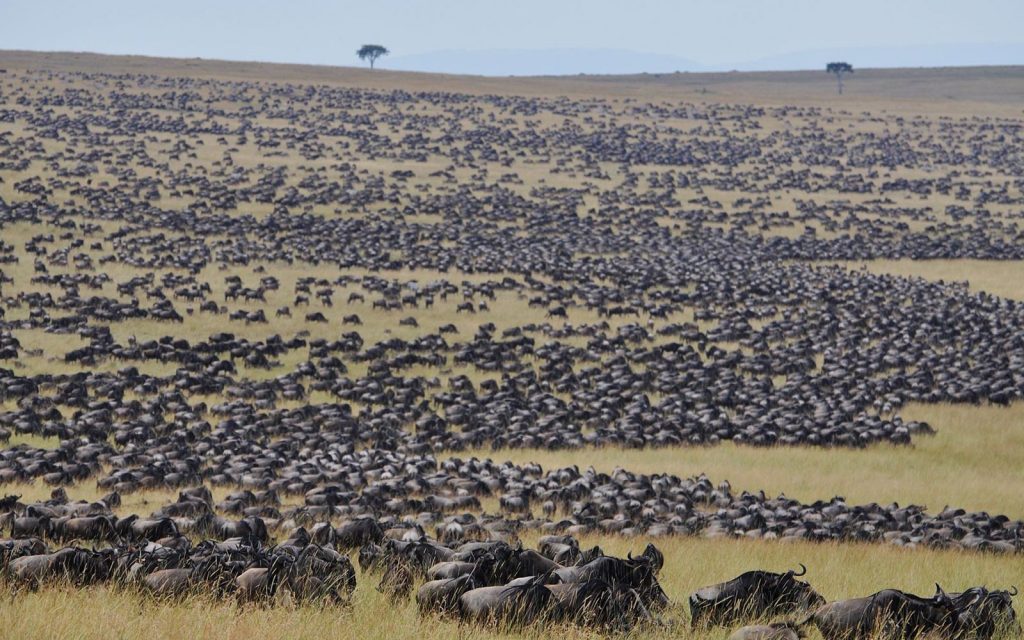
The Best Time to See The Great Wildebeest Migration
The Great Migration presents year-round opportunities for enjoyment. Remarkable predator encounters occur in the initial months, particularly in Tanzania’s Serengeti. It coincides with the wildebeest calving season, rendering the newborns vulnerable targets. By July, the herds migrate northward into the central Serengeti. This marks their first river crossing at the Grumeti River, confronting the peril of crocodiles. August sees their transition into Kenya’s Masai Mara by crossing the Mara River. Towards year’s end, they journey southward back into the Serengeti through Namiri Plains. Here, they prepare for the impending calving season and the threat of predator attacks. Hence, this cyclical movement characterizes the migration’s continuous journey, providing diverse wildlife experiences throughout the year. Witnessing the vulnerability of newborns to confronting natural obstacles like river crossings and predator encounters.
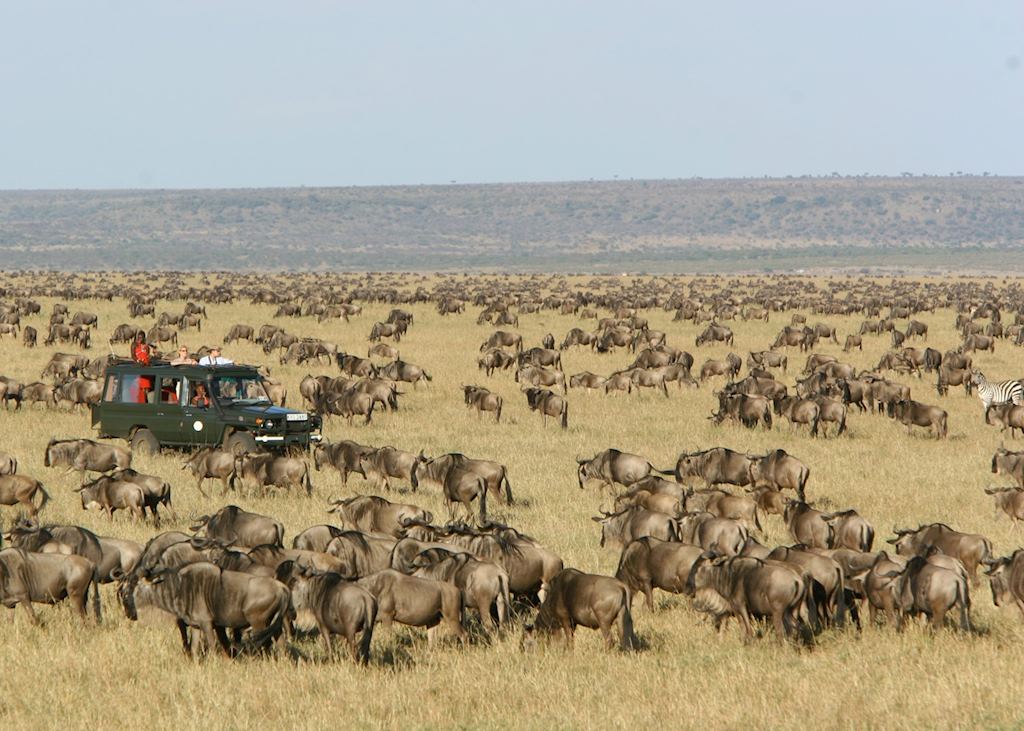
How The Great Wildebeest Migration Moves All Year Round
Throughout the year, the Great Migration maintains its relentless pace. Whether the wildebeest are birthing calves or navigating treacherous river crossings while evading predators. This cyclical journey commences from the Ngorongoro Conservation Area in the southern region of Tanzania’s Serengeti National Park. It extends northwards through the Serengeti National Park itself. Onward across the Mara River into Kenya’s Masai Mara National Reserve, only to circle back again. The Great Migration is fraught with peril at every turn: vulnerable newborn calves fall prey to the big cats. Slower individuals succumb to lion prides as courageous animals suffer injuries on the steep riverbanks of the Grumeti River. The Mara River crocodiles seize stragglers, and the weary and feeble perish in the currents.
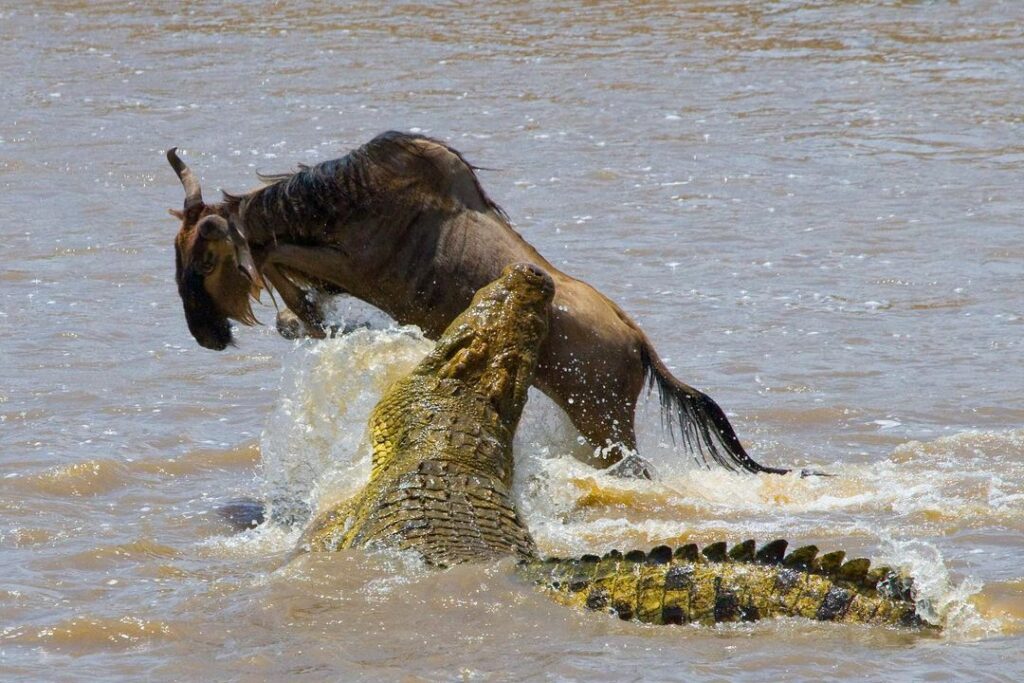
The Great Migration from January to March
Each January, the migration concludes its southward journey, traversing the eastern edge of the Serengeti into the Ngorongoro Conservation Area. The fertile plains offer abundant, nourishing grasslands, ideal for nurturing the herds’ newborn calves.
While the migratory circuit lacks a defined beginning or end, save for the cycles of birth and death, it’s reasonable to mark the wildebeests’ calving season as the migration’s onset. In late January or February, the herds converge upon the short-grass plains sprawling across the lower northern slopes of the Ngorongoro Crater highlands and surrounding the Olduvai Gorge. Within two to three weeks, approximately 400,000 calves are birthed, translating to nearly 8,000 newborns arriving each day. This surge in vulnerable young calves triggers a corresponding surge in predator activity, with the abundance of prey making hunting easier for the surrounding predators.
For those keen on observing the spectacle of calving and the intense drama of big cats in pursuit, the time between mid-month of January and all the months of February and March is the right time to capture the moments live as the raw magnificence unfolds.
The Great Wildebeest Migration from April to May
Following the birth of their Calves in February and March, around April, the wildebeest herds gradually shift northwestward, seeking the lush grasslands of the central Serengeti National Park. Accompanied by thousands of zebras and smaller groups of antelopes, they form elongated columns stretching several kilometers. By May, the wildebeest herds converge near the Moru Kopjes, past Kusini Airstrip, towards the western corridor. Mating season commences towards late May, prompting male wildebeests to engage in fierce battles. During this rut period, the journey progresses leisurely, with the wildebeests, zebras, and gazelles grazing as they traverse the landscape.

As the migration progresses, the wildebeest gathers momentum and congregates in the Western Corridor of the Serengeti. During this period, Divulge Adventures curates customized safari packages for migration tracking, offering opportunities to witness the wildebeests’ crossing of the Grumeti River. While not as dramatic as the Mara crossings, the sight of the vast herds navigating the river’s pools still attracts attention. Despite being the low season at the Grumeti Reserve in May, safaris during this time present excellent value, as there are fewer tourists in the Serengeti while wildlife sightings remain abundant.
The Great Wildebeest Migration from June to July
As June unfolds, the onset of the dry season sees significant concentrations of wildebeest in the Western Serengeti. Also, along the southern banks of the Grumeti River. Each member of the migrating herds faces the daunting challenge of crossing this crocodile-infested river, marking the beginning of numerous perilous river crossings.
Progressing from June into July, hundreds of thousands of wildebeest and zebras continue their journey northward along the park’s western boundary. Approaching an even more hazardous obstacle: the Mara River in the northern Serengeti. These river crossings are widely regarded as one of the most thrilling wildlife spectacles on the planet. Although they typically commence with the onset of the high season in July, the exact timing is dictated by natural conditions.
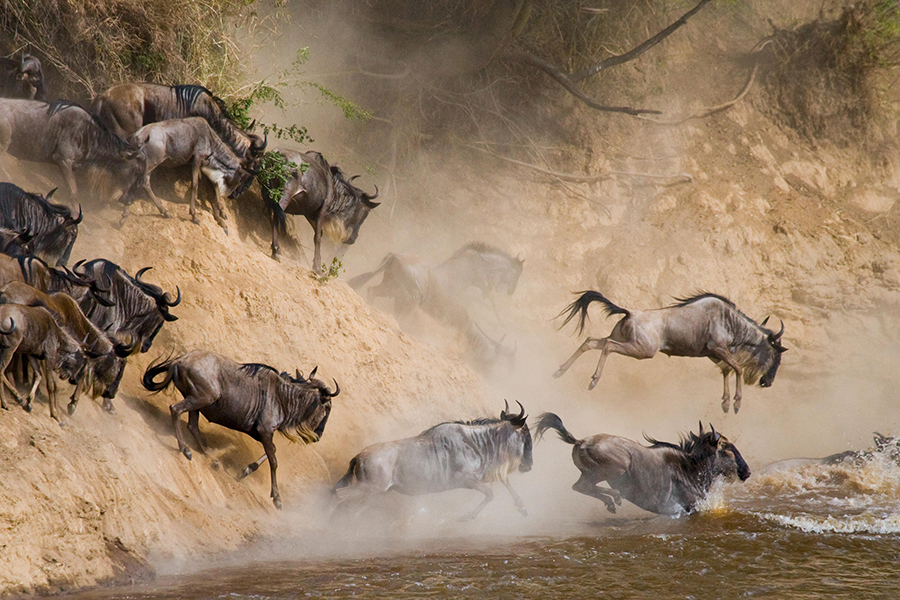
During July, the herds predominantly occupy the Northern Serengeti. Towards late July, animals that have successfully traversed the Mara River can also be spotted in the Masai Mara at the Mara Triangle Conservancy. During this period, daily river crossings unfold at the Mara and Talek rivers, often offering breathtaking scenes of wildlife in motion.
The Great Wildebeest Migration from August to October
By August, the herds have completed the challenging Mara River crossings, scattering across the northern region of the Masai Mara and remaining in the northern Serengeti. During years of vigorous river flow, crossings provoke panic and chaos, resulting in substantial casualties from predators and swift currents. Even in milder river conditions, crocodiles and lions take their toll on the migrating herds. The crossings vary in intensity, with some spots witnessing sparse individuals while others observe continuous streams of animals for hours. By September to October, the chaos subsides gradually as the herds progress eastward, gearing up to confront the heavy waters of the Mara River once more as they prepare to cross once again for their return journey southward to Serengeti.
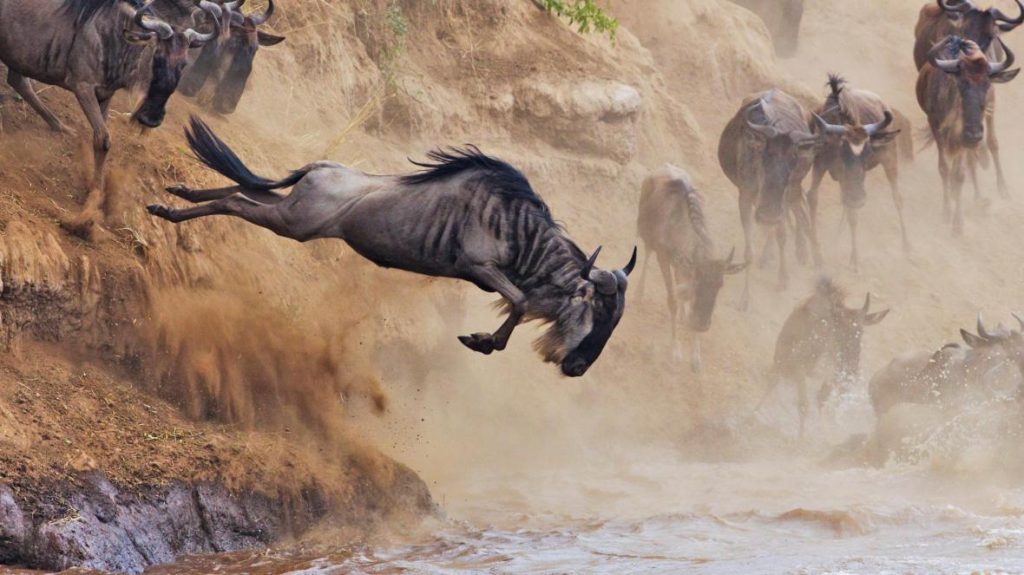
The Great Wildebeest Migration from November to December
Following the East African short rains between late October and early November, the wildebeest migrate from Kenya’s Masai Mara into the eastern regions of Tanzania’s Serengeti, passing through Namiri Plains, well renowned for its exceptional cheetah sightings. By December, they disperse across the eastern and southern expanses of the Serengeti.
In the initial months of the following year, the southern Serengeti boasts lush grasslands due to rainfall. This attracts vast herds of wildebeest and hundreds of thousands of zebras and other plains-dwelling animals. This perpetuates the cycle as the calving season commences once more.
